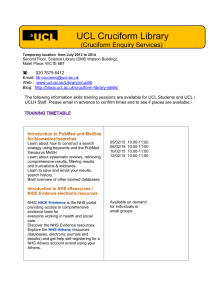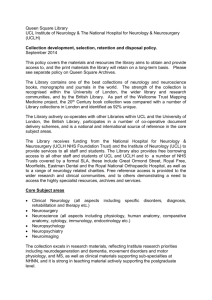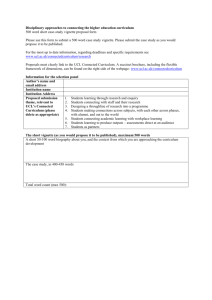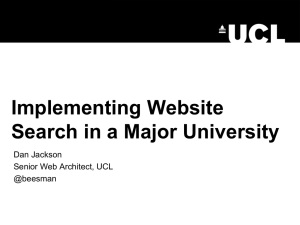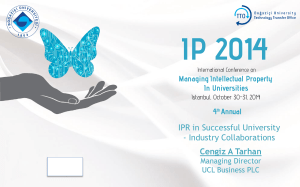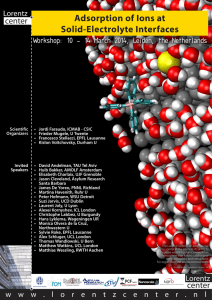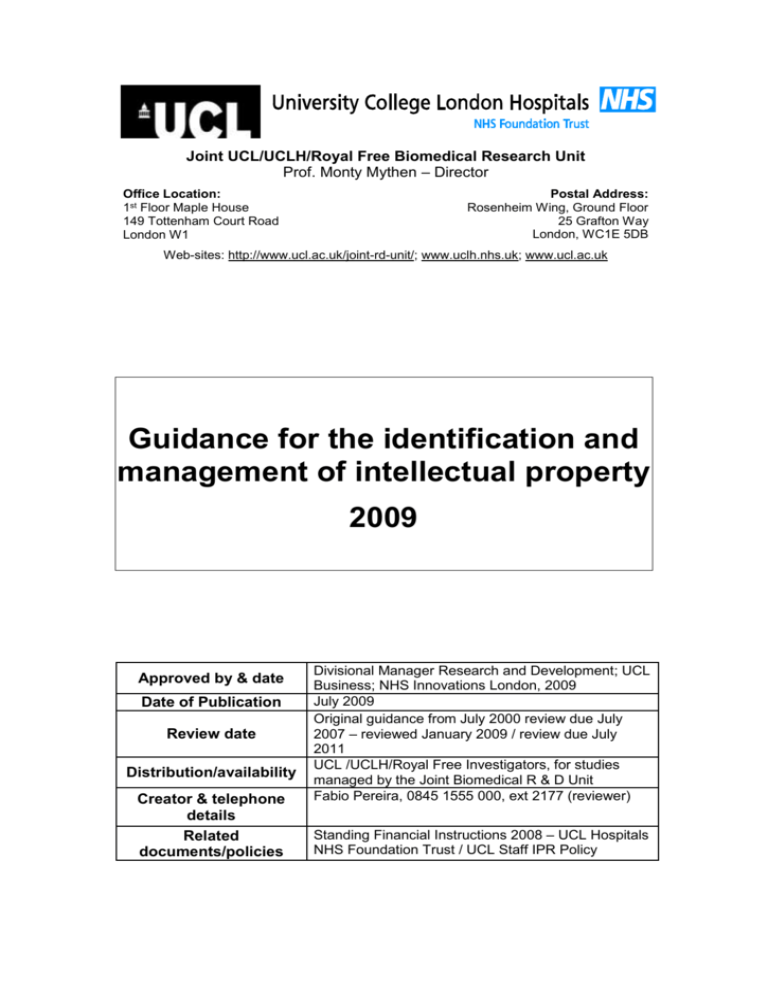
Joint UCL/UCLH/Royal Free Biomedical Research Unit
Prof. Monty Mythen – Director
Office Location:
1st Floor Maple House
149 Tottenham Court Road
London W1
Postal Address:
Rosenheim Wing, Ground Floor
25 Grafton Way
London, WC1E 5DB
Web-sites: http://www.ucl.ac.uk/joint-rd-unit/; www.uclh.nhs.uk; www.ucl.ac.uk
Guidance for the identification and
management of intellectual property
2009
Approved by & date
Date of Publication
Review date
Distribution/availability
Creator & telephone
details
Related
documents/policies
Divisional Manager Research and Development; UCL
Business; NHS Innovations London, 2009
July 2009
Original guidance from July 2000 review due July
2007 – reviewed January 2009 / review due July
2011
UCL /UCLH/Royal Free Investigators, for studies
managed by the Joint Biomedical R & D Unit
Fabio Pereira, 0845 1555 000, ext 2177 (reviewer)
Standing Financial Instructions 2008 – UCL Hospitals
NHS Foundation Trust / UCL Staff IPR Policy
Guidance for the identification and management of Intellectual Property
This guidance is aimed at UCL/UCLH/Royal Free staff, having interest in
Intellectual Property, potential inventors, more specifically in the area of
medical research, for projects managed by the Joint UCL/UCLH/Royal Free
Biomedical R & D Unit.
This guidance describes what Intellectual Property Rights (IPRs) are and how
they should be handled at UCL/UCLH and the Royal Free. The Joint
UCL/UCLH/Royal Free Biomedical R & D Unit deals with all IPRs issues
arising from medical research 1 and works closely with NHS Innovations
London (NHSIL) http://www.nhsinnovationslondon.com/about-us/our-team/32/
and UCL Business (UCLB) http://www.uclb.com/ to ensure the effective
identification and management of UCL/UCLH/Royal Free IPRs.
1) What is IP?
The term intellectual property refers broadly to the creations of the human
mind. IPRs protect the interests of creators by giving them property rights over
their creations (see section 3).
Although there is no unequivocal definition of IP, it is right to say that the
subject matter protected by IPRs are:
literary, artistic and scientific works;
performances of performing artists, phonograms, and broadcasts;
inventions in all fields of human endeavour;
scientific discoveries;
industrial designs;
trademarks, service marks, commercial names and designations;
protection against unfair competition; and
“all other rights resulting from intellectual activity in the industrial,
scientific, literary or artistic fields.”2
Therefore, IP can include inventions, industrial processes, software, data,
written work, designs and images. It has an owner/s and can be bought, sold
or licensed. People who generate IP are commonly known as inventors or
creators. For example, Trust staff invented a device to help pharmacists fill
syringes. UCLH has licensed the invention to a company to manufacture and
the company pays UCLH royalties on sales.
2) What are IP rights?
IP rights give the owner the legal right to prevent others from exploiting their
property, for a limited period of time as established by the law. Intellectual
property can be costly and time-consuming to produce, and may require a
1
2
All medical activities including clinical research.
Convention Establishing the World Intellectual Property Organisation, article 2, (viii).
considerable degree of inventiveness or originality. Without IPRs, it is argued,
nothing would prevent others from taking advantage of (or ‘free riding’ on) this
intellectual capital, without incurring its original costs. As a result, IPRs offer
an important incentive for the creation of new intellectual capital. The purpose
of seeking protection for innovations through IPRs is to provide a commercial
advantage to the organisation or individual who takes the product/service to
market, without which it is often difficult to secure competitive position.
3) How is IP protected?
IP can be protected through patents, trademarks, industrial designs, and
geographical indications of source, under the Industrial property category, and
Copyright and related rights, under the Copyright category.
Patents - a patent provides protection for original inventions with
industrial application. The protection is granted to the proprietor for a
limited period, generally 20 years. There are a number of excluded
categories such as methods of treatment of the human body or animal
body, by surgery or therapy, or methods of diagnosis, or discoveries of
natural substances, plant or animal varieties, and scientific theories.
One of the most important aspects of patent protection is that an
invention must be ‘novel’ meaning that it must be new. For this reason,
an invention or details about it should not have been previously
disclosed, for example in a scientific paper, poster, presentation (oral
or written) or exhibition before an application is made to protect the
invention (contact the Joint UCL/UCLH/Royal Free Biomedical R & D
Unit for further clarification).
Trademarks - a trademark is a distinctive sign which identifies certain
goods or services as those produced or provided by a specific person
or company. A trademark provides protection to the owner of the mark
by ensuring the exclusive right to use it to identify goods or services, or
to authorise another to use it in return for payment. Trademarks can be
registered or unregistered. A registered trademark ® is often much
more valuable than an unregistered trademark which can only give the
owner a right to sue for passing off. It is more difficult and expensive to
bring an action for passing off than for straightforward infringement of a
registered trademark.
Industrial Designs - industrial designs are what make an article
attractive and appealing; hence, they add to the commercial value of a
product and increase its marketability. When an industrial design is
protected, the owner is assured an exclusive right against unauthorised
copying or imitation of the design by third parties. Registered designs
protect the shape, configuration, pattern or ornament of an article to the
extent that they are new and have ‘individual character’ (e.g. the
distinctive Coca-Cola bottle). Unregistered design right is a proprietary
right which subsists in an original design.
Geographical indications - signs used on goods that have a specific
geographical origin and possess qualities, reputation or characteristics
that are essentially attributable to that place of origin. Most commonly,
a geographical indication includes the name of the place of origin of the
goods. Geographical indications may be used for a wide variety of
products, whether natural, agricultural or manufactured.
Copyright © - is a legal term describing rights given to creators for
their literary and artistic works. A copyright work must be original (not
necessarily novel or new). The types of works covered by copyright
include: literary works such as novels, poems, plays, reference works,
newspapers and computer programs; databases; films, musical
compositions, and choreography; artistic works such as paintings,
drawings, photographs and sculpture; architecture; and advertisements,
maps and technical drawings. Copyright is an unregistered intellectual
property right, which arises automatically under UK law when a
protectable work is created by a qualifying author, and there is no
registration required. Computer software is protected by Copyright in
the same way as literary and artistic works.
Databases – these are protected in one of two ways. Some databases
can be protected as copyright works when the person compiling the
database is judged to have used sufficient skill, labour and judgement
in devising the compilation. Other databases are protected by a
separate Database Right. This right generally lasts for 15 years.
Databases protected by Database Right tend to protect the content, as
opposed to the organisation and structure of a database.
Know-How – refers to technical expertise or practical knowledge (e.g.
methodologies) and can encompass a broad and vague body of
knowledge. Know-How is sometimes called Trade Secrets. In some
cases this may be commercially valuable and can be exploited through
consultancy or licensing and can be protected through the law of
confidentiality.
There is also protection for confidential information under the law of
confidence, which is based on contract or equity.
4) Why do anything about IP?
IP must not simply be given away. By granting an exclusive right, patents, for
example, provide incentives to individuals and organisations, offering them
recognition for their creativity and material reward for their marketable
inventions. These incentives encourage innovation, which, in turn, contribute
to the continuing enhancement of the quality of human life.
It is important to note the difference between assigning and licensing IP rights.
Assignment is the term given to the outright transfer of ownership of IP rights
from one person or party to another. It is often, but not always, done in return
for a fee. Licence is the term given to the permission, which the owner of an
intellectual property right may give to any other person or parties to use that
IP right. There is no transfer of ownership in the latter, but the owner may also
charge a fee in return for the grant of a licence and can impose terms and
conditions on the IP use.
For UCLH and Royal Free IP it is worth mentioning that until April 1998, IP
was not owned by UCLH or the Royal Free, it was owned by the Secretary of
State. Since then, it has been owned by individual trusts. It is a Department
of Health requirement that the Trust actively manages its IP.
5) Who owns the IP?
UCL and/or UCLH and/or the Royal Free probably own(s) the IP with some
exceptions. That will depend on the type of IP generated and the
circumstances of each individual case. As an example, in accordance with the
Patents Act 1977, the employer is entitled to ownership of an invention made
by the employee in the course of his normal duties or in the course of other
duties specifically assigned to him and the circumstances were such that an
invention ‘might reasonably be expected to result from carrying out those
duties’3 (e.g. the employee has been hired specifically to undertake research
and development). The employer is also entitled to own the invention if the
employee had a special obligation to further his employer’s interests and the
invention was made in the course of his duties.4
Any other invention made by the employee shall be taken to belong to the
employee.5 You should contact the Joint UCL/UCLH/Royal Free R & D Unit
(Fabio Pereira) or NHSIL (Dr Louise Larkin) to seek clarification in these
circumstances.
In the case of externally-funded work, arrangements may be made for the
funding body or company to own the IP or for UCL/UCLH/Royal Free to have
a share of the rights, as the case may be. Although it is likely that funding
contracts will be dealt by UCL Research Administration or UCLH Finance or
the Royal Free Finance, arrangements for IP share would be set-up by the
Joint UCL/UCLH/Royal Free Biomedical R & D Unit.
Companies will often only invest in developing an invention if the IP is
adequately protected.
Members of UCLH staff shall ensure that any original work, manuscript, data,
report, or other written material in which copyright belongs to UCLH bears a
statement that the copyright belongs to University College London Hospitals
NHS Foundation Trust. This should normally take the form of ‘© University
College London Hospitals NHS Foundation Trust. All rights reserved’ or ‘©
UCLH. All rights reserved’.6
For UCL employees, advice shall be sought from the UCL Copyright Officer.
For Royal Free employees, advice shall be sought from the Joint Biomedical
UCL/UCLH/Royal Free R & D Unit.
3
Patents Act 1977, s 39 (1) a.
Patents Act 1977, s 39 (1) b.
5 Patents Act 1977, s 39 (2).
6 Standing Financial Instructions 2008 – UCL Hospitals NHS Foundation Trust, Appendix 7, 2.4.
4
6) Who benefits from the IP?
For UCLH and Royal Free employees, the Joint Biomedical R & D Unit shall
inform the inventor(s) whether the Trust wishes to protect and exploit the
invention, and shall advise as to whether any delay in publication of the
invention is advisable. Should the Trust decide not to take up its rights to
exploit, the Trust can offer to assign all rights in the invention to the inventor(s)
(to exploit in the inventor’s own name and at the inventor’s own expense).7
Should the Joint UCL/UCLH/Royal Free Biomedical R & D Unit decide that
the Trust should protect and exploit the invention, IP protection (in most cases,
patent protection) in the name of UCLH or the Royal Free will be investigated.
Where UCLH or the Royal Free makes a commercial agreement for the
exploitation of IP rights, the net income received from the licensing or,
exceptionally, direct exploitation of the IP rights shall, after deduction of all
relevant expenditure incurred through exploitation or protection, will normally
be distributed between UCLH or the Royal Free and the inventor through an
income share agreement (which will be provided by the Joint Biomedical R &
D Unit upon request). The executive Board will issue guidelines for the
distribution of such income but maintains its right to vary the proportionate
share income depending on the circumstances of each case.8
If an inventor is jointly employed with another institution, for example UCL,
then revenues will be shared according to NHS guidance and agreement with
the other institution. If the inventor has any other arrangement to benefit
financially from the IP from a source other than UCLH or the Royal Free (for
example, they are paid by a company exploiting the IP) then UCLH or the
Royal Free will not normally make any payments to the inventor. Note that
NHS Trusts are not legally required to share any IP income with employees
and sharing is at their absolute discretion.
In relation to books, UCLH and the Royal Free do not exercise any right they
may have under Statute law in case of academic publications such as text
books which are published by commercial publishers. In such cases, an
author who is a UCLH or Royal Free employee may dispose of or assign the
literary copyright to the publisher and UCLH or the Royal Free does not
expect any share of royalty received by the author.9
For UCL employees, there is a UCL Staff IPR policy (Policy Statement on
Intellectual Property Rights/Copyright in relation to staff) available at
http://www.ucl.ac.uk/Library/scholarly-communication/ipr.shtml,
where
revenue-sharing arrangements have been put in place.
7) What should I do if I believe I have some IP?
If you believe you have created, developed or discovered anything that should
give rise to IP, then contact the Joint UCL/UCLH/Royal Free Biomedical R &
Standing Financial Instructions 2008 – UCL Hospitals NHS Foundation Trust, Appendix 7, 2.2.
Standing Financial Instructions 2008 – UCL Hospitals NHS Foundation Trust, Appendix 7, 2.3
9 Standing Financial Instructions 2008 – UCL Hospitals NHS Foundation Trust, Appendix 7, 1.3
7
8
D Unit for guidance. The Joint Unit has access to IP, legal and marketing
expertise internally and has established links with NHS Innovations London
(NHSIL) and UCL Business (UCLB). A decision will be made on whether the
IP can and should be protected. If the IP is to be protected, then the Joint R &
D Unit will either handle the arrangements directly with NHSIL/UCLB or
support the member of staff in taking the IP forward with them. The Joint R &
D Unit and/or NHSIL/UCLB may also liaise with universities and trusts to
clarify ownership. There are agreements in place with UCLB and NHSIL who
act on UCL/UCLH’s behalf respectively for the management and
commercialisation of IP rights.10
8) Who should I tell?
You should immediately refer all details to the Joint UCL/UCL/Royal Free
Biomedical R & D Unit (Fabio Pereira, Legal Affairs & IP Manager
f.pereira@ucl.ac.uk and Nick McNally, Director of Research Support
n.mcnally@ucl.ac.uk).
Please note that premature disclosure of any information in respect of an
invention can seriously prejudice the prospects for commercial exploitation. It
is therefore essential that staff who make an invention or discovery in the
course of work within their contract of employment, or whilst specifically under
the direction or control of UCL, UCLH or the Royal Free, or engaged in duties
for research, or using UCL/UCLH/Royal Free staff, facilities, material, etc.,
notify their Head of Department in writing, and also immediately refer all
details to the Joint UCL/UCLH/Royal Free Biomedical R & D Unit.11 We will
arrange confidentiality agreements where necessary. Advice on whether an
invention/discovery can be protected can be obtained within days and should
not unduly delay publication of results.
Responsibility for the protection and exploitation of IP rights, including any
negotiation with external funders or companies in respect of such rights, rests
with UCL/UCLH/Royal Free and is coordinated by the Joint UCL/UCLH/Royal
Free Biomedical R & D Unit, with the support of NHSIL and UCLB.
10
11
Standing Financial Instructions 2008 – UCL Hospitals NHS Foundation Trust, Appendix 7, 2.1
Standing Financial Instructions 2008 – UCL Hospitals NHS Foundation Trust, Appendix 7, 1.5
Summary Flowchart
I have an idea or an invention – what should I do?
The first, most important thing, is not to jeopardise the chance of
being able to gain protection for your invention. In practice this
means not releasing any details to the public, that aren’t already
known to the public. This can be by holding back on publication,
and by being careful who you tell about the idea.
The second thing is to contact the Joint UCL/UCLH/Royal Free
R & D Unit for more information and to fill out an Invention
Disclosure form. This is a confidential form that explains your
invention, why you think it is worth protecting and why it may be
a commercial success in the future. This form will then be
discussed by senior staff at the Joint Unit, and a decision will be
reached as to whether we can help the invention gain
protection, with the support of NHSIL and UCLB.
Thirdly, a description of the invention, stating the key features that
make it different to the inventions before it must be prepared.
This is done by UCLB or NHSIL to make
sure that it is laid out in the correct format, but any information
that you can provide is helpful.
Fourthly, continuing to be careful as regards giving out information
to third parties about the invention is vital. This can include other
researchers as well as companies. If you are approached by a
company who would like more information, it is important that this is
protected by a Confidential Disclosure Agreement (for more
information on these, please contact the Joint Biomedical R & D
Unit). This is something that can be arranged by the Joint Unit, and
help to prevent situations where inventions get ‘stolen’, leaving the
inventor in a bad position.
References:
Bently, Lionel & Sherman, Brad (2004) ‘Intellectual Property Law’, 2nd
ed., Oxford University Press, Oxford.
Davis, Jennifer (2005) ‘Intellectual Property Law’, 2nd ed., Oxford
University Press, Oxford.
NHS Innovations website < http://www.nhsinnovationslondon.com>
(accessed 23 Jan 2009).
World Intellectual Property Organization (WIPO) website
http://www.wipo.int/portal/index.html.en> (accessed 28 July 2008).
UCL Staff IPR policy (Policy Statement on Intellectual Property
Rights/Copyright
in
relation
to
staff)
available
at
<http://www.ucl.ac.uk/Library/scholarly-communication/ipr.shtml>
(accessed 23 Jan 2009).
UCL Hospitals NHS Foundation Trust Standing Financial Instructions
2008.
Fabio Pereira
July 2009
<


